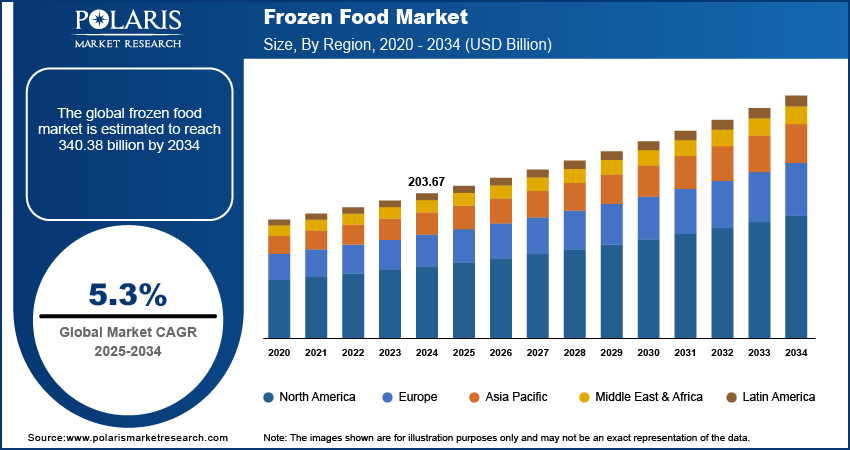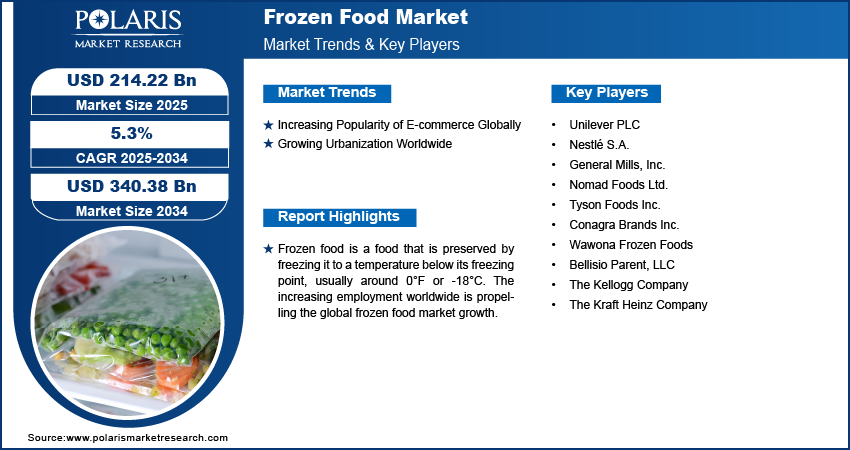
Frozen Food Market Share, Size, Trends, Industry Analysis Report, By Product (Frozen Meat & Poultry, Frozen Vegetables and Fruits, Frozen Ready Meals, Frozen Seafood, Frozen Snacks); By Distribution Chanel; By Type; By End-Use; By Region; Segment Forecast, 2023 - 2032
- Published Date:Dec-2023
- Pages: 115
- Format: PDF
- Report ID: PM1139
- Base Year: 2022
- Historical Data: 2019-2021
Report Outlook
The global frozen food market was valued at USD 395.06 billion in 2022 and is expected to grow at a CAGR of 4.4% during the forecast period.
Frozen ready meals, frozen seafood and meat, frozen snacks and bakery items, and other offerings like frozen fruits and vegetables represent diverse categories of frozen products accessible in the worldwide market. These products are distributed through various channels, including supermarkets/hypermarkets, convenience stores, specialty stores, and online retail platforms.

To Understand More About this Research: Request a Free Sample Report
The convenience provided by ready-to-eat food products is the key driver of the processed food industry, appealing to consumers across all age groups. The global market has witnessed a rapid transformation in consumer preferences towards convenient and ready-to-eat (RTE) foods. Packaged foods, requiring less time and effort compared to cooking from scratch, are in high demand, particularly frozen or convenience food products. The rising disposable incomes of consumers further contribute significantly to the flourishing market, indicating continued growth in the coming years.
- For Instance, Wells Enterprises, Inc., the parent company of Halo Top, introduced a collection of refreshing sorbet pints as part of the renowned ice cream brand's latest offerings.
Increasing desire for convenient food options, betterment in cold chain technology, and inventions in retail are key factors driving the expansion of the market. The demand for frozen food products is on the rise, driven by the reduced time and effort required compared to preparing meals at home. The freezing process not only stretches the shelf life of food by slowing down decomposition but also hinders the growth of bacteria. With microorganisms unable to thrive at temperatures below 15 degrees Fahrenheit, the need for preservatives in frozen food products is significantly minimized, further contributing to the growth of the market.
The COVID-19 pandemic has significantly impacted the frozen food market. The lockdowns and social distancing measures have been implemented to restrain the spread of the virus have changed consumer behavior and preferences, driving a surge in demand for frozen foods. With people spending more time at home and prioritizing convenience, frozen foods have gained popularity due to their longer shelf life and ease of preparation.
However, the pandemic has disrupted the supply chain and manufacturing processes, leading to challenges and fluctuations in the availability of products. The shutdown of restaurants and food service establishments has shifted the focus to retail channels, leading to increased sales in supermarkets and online platforms. Additionally, concerns about food safety have spurred consumers to turn to frozen foods as a safer option.
Frozen food manufacturers have adapted strategies to meet changing consumer needs. Innovation in product development, packaging, and marketing has become crucial for companies to stay competitive in the post-pandemic landscape. As the world continues with the uncertainties of the pandemic, the frozen food market is likely to witness a mix of challenges and opportunities, with adaptability and agility being key factors for sustained success in the industry.

For Specific Research Requirements: Request for Customized Report
Producers of frozen food are blending advanced technologies, such as Individually Quick-Frozen (IQF) technology, to elevate the quality of their food offerings. In this process, food items are placed on a conveyor belt and rapidly transported to a blast freezer, where quick freezing occurs. Unlike conventional block or bulk freezing methods, IQF technology ensures that every molecule within the product is frozen individually. This approach contributes to superior product quality, preserving higher nutritional values in frozen food.
Industry Dynamics
Growth Drivers
- Extension of convenience stores and increasing working people population will facilitate market growth
The market growth of frozen foods is driven by the expansion of convenience stores and surging working professionals population. The expansion of convenience stores has become increasingly convoluted with the growing working-class population, particularly in urban and suburban areas. As the demands of a fast-paced lifestyle continue to rise, convenience stores have evolved beyond traditional offerings, including a diverse range of products to meet the needs of their busy customers. Frozen Food Market has witnessed significant growth in this sector.
The frozen food market has become a focal point for convenience stores aiming to provide quick and easy meal solutions for individuals with limited time for meal preparation. These stores now stock a wide variety of frozen options, including ready-made meals, snacks, and ingredients, catering to the working-class demographic seeking both convenience and quality. This coordinated relationship between convenience stores and the frozen food market reflects a strategic response to the evolving consumer landscape, where time efficiency and accessibility are essential considerations for the dynamic working-class population.
Report Segmentation
The market is primarily segmented based on product, distribution channel, type, end-use and region.
|
By Product |
By Distribution Channel |
By Type |
By Region |
|
|
|
|
To Understand the Scope of this Report: Speak to Analyst
By Product Analysis
- The frozen meat & poultry segment accounted for the largest revenue share in 2022
The frozen meat & poultry segment accounted for the largest revenue share. The frozen meat and poultry category includes a variety of products such as frozen chicken, meatballs, chicken breast, beef patties, steak, nuggets, and sausage. Proper defrosting and thawing are crucial to ensure safe consumption. The significant factors driving this segment include high nutritional content and an extended shelf life of frozen meat and poultry. The market is anticipated to witness further growth due to the increasing adoption of busy lifestyles and the constantly changing schedules of individuals.
On the other hand, the frozen snacks segment is expected to witness substantial growth. The rising consumption of convenience foods like frozen burgers, pizza, potato wedges, and French fries is anticipated to be a key factor driving the expansion of the frozen snacks market. The increasing preference for frozen snacks among teenagers, connected with their suitable preparation, is confident to contribute significantly to the growth of the market.
By Distribution Channel Analysis
- The supermarkets segment accounted for the highest market share during the forecast period
The supermarkets segment accounted for the highest market share during the forecast period. These markets are rapidly evolving, which is reshaping the retail industry. The main concept driving these changes is prioritizing consumer choice and comfort. To influence this concept, manufacturers are increasingly distributing their products through hypermarkets and supermarkets. The expansion of supermarkets is primarily expanding in developing nations, with these establishments now extending to tier 2 and 3 cities. This expansion assures a diverse range of products is accessible in smaller towns. The key role of this factor is to significantly contribute to the growth of this segment in emerging markets.
On the other hand, online retail segment is anticipated to experience significant growth throughout the forecast period. The convenience of accessing a diverse array of products in one location through a smartphone and the internet serves as a key catalyst for the expansion of online retail. This allows consumers to effortlessly make purchases from the comfort of their homes, with the added convenience of doorstep delivery. Moreover, a large number of working professionals are buying edible products online and the number is anticipated to increase in the future, which could be advantageous for the growth of the market.
Regional Insights
- Europe accounted for the largest market share in 2022
Europe accounted for the largest market contributor in the frozen food market. The rise in the number of vegans in the region is fueling the demand for frozen vegetables and serves as a pivotal factor for the region's market growth. Economic stability, strong consumer purchasing power, and shifts in food preferences are additional significant drivers of market expansion in the region. Additionally, the bustling and fast-paced lifestyles of individuals have led to an increased desire for convenient, ready-to-eat breakfast options.
North America region is anticipated for the fastest growth owing to elevated consumer awareness with respect to frozen food products. The FDA has implemented several regulations to limit the inclusion of chemicals, including trans fats, by manufacturers. Frozen foods, being pre-cut, pre-washed, and occasionally partially cooked before packaging and freezing, necessitate minimal cooking time. This not only enhances portability but also extends their shelf life, contributing to the growth of the market.
Key Market Players & Competitive Insights
The market is characterized by intense competition, with established players relying on advanced technology, high-quality products, and a strong brand image to drive revenue growth. These companies employ various strategies such as research and development, mergers and acquisitions, and technological innovations to expand their product portfolios and maintain a competitive edge in the market.
Some of the major players operating in the global market include:
- Ajinomoto
- Cargill
- Conagra Brands, Inc.
- Europastry S.A.
- General Mills Inc.
- Grupo Bimbo
- JBS
- Kellogg Company
- Lantmannen Unibake
- Nestle SA
- The Kraft Heinz Company
- Unilever
- Vandemoortele NV
Recent Developments
- In May 2022, Redefined Meat, a renowned plant-based meat company, has unveiled its frozen meat products in Italy as part of its strategic expansion into the European market, leveraging its significant presence in the global market.
- In April 2022, Prasuma, a prominent frozen meat brand in India, has launched its product range by introducing a variety of new frozen snacks. This latest product launch encompasses frozen chicken nuggets, frozen vegetables, and chicken spring rolls, along with other enticing snack options.
- In February 2022, Seara, a renowned food brand recognized for its premium frozen food offerings, launched a groundbreaking addition to the frozen food category with its latest products. Introducing the Seara Shawaya, this innovative chicken for roasting addresses a market void that was previously unmet by any other product.
Frozen Food Market Report Scope
|
Report Attributes |
Details |
|
Market size value in 2023 |
USD 410.78 billion |
|
Revenue forecast in 2032 |
USD 604.17 billion |
|
CAGR |
4.4% from 2023 – 2032 |
|
Base year |
2022 |
|
Historical data |
2019 – 2021 |
|
Forecast period |
2023 – 2032 |
|
Quantitative units |
Revenue in USD billion and CAGR from 2023 to 2032 |
|
Segments Covered |
By Product, By Distribution Channel, By Type, By End-Use, By Region |
|
Regional scope |
North America, Europe, Asia Pacific, Latin America; Middle East & Africa |
|
Customization |
Report customization as per your requirements with respect to countries, region and segmentation |
FAQ's
The frozen food market report covering key segments are product, distribution channel, type, end-use and region.
Frozen Food Market Size Worth $476.24 Billion By 2032
The global frozen food market is expected to grow at a CAGR of 4.4% during the forecast period.
Europe is leading the global market.
key driving factors in frozen food market are Extension of convenience stores and increasing working people population will facilitate market growth

